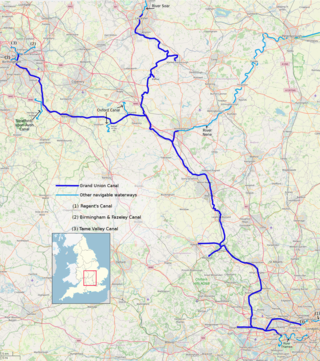
The Grand Union Canal in England is part of the British canal system. It is the principal navigable waterway between London and the Midlands. Starting in London, one arm runs to Leicester and another ends in Birmingham, with the latter stretching for 137 miles (220 km) with 166 locks from London. The Birmingham line has a number of short branches to places including Slough, Aylesbury, Wendover, and Northampton. The Leicester line has two short arms of its own, to Market Harborough and Welford.
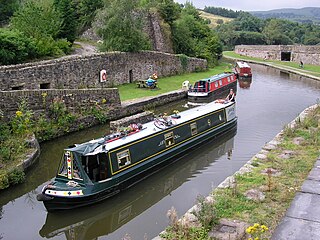
A narrowboat is a particular type of canal boat, built to fit the narrow locks of the United Kingdom. The UK's canal system provided a nationwide transport network during the Industrial Revolution, but with the advent of the railways, commercial canal traffic gradually diminished and the last regular long-distance transportation of goods by canal had virtually disappeared by 1970. However, some commercial traffic continued. From the 1970s onward narrowboats were gradually being converted into permanent residences or as holiday lettings. Currently, about 8580 narrowboats are registered as 'permanent homes' on Britain's waterway system and represent a growing alternative community living on semi-permanent moorings or continuously cruising.

The Oxford Canal is a 78-mile (126 km) narrowboat canal in southern central England linking the City of Oxford with the Coventry Canal at Hawkesbury via Banbury and Rugby. Completed in 1790, it connects to the River Thames at Oxford, and links with the Grand Union Canal, which it is combined with for 5 miles (8 km) between to the villages of Braunston and Napton-on-the-Hill.

Ashton-under-Lyne is a market town in Tameside, Greater Manchester, England. The population was 45,198 at the 2011 census. Historically in Lancashire, it is on the north bank of the River Tame, in the foothills of the Pennines, 6 miles (9.7 km) east of Manchester.

A horse-drawn boat or tow-boat is a historic boat operating on a canal, pulled by a horse walking beside the canal on a towpath.
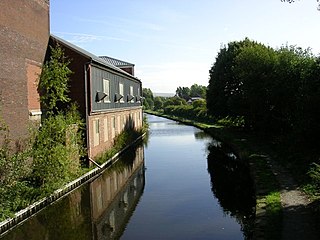
The Ashton Canal is a canal in Greater Manchester, England, linking Manchester with Ashton-under-Lyne.

The Huddersfield Narrow Canal is an inland waterway in northern England. It runs just under 20 miles (32 km) from Lock 1E at the rear of the University of Huddersfield campus, near Aspley Basin in Huddersfield, to the junction with the Ashton Canal at Whitelands Basin in Ashton-under-Lyne. It crosses the Pennines by means of 74 locks and the Standedge Tunnel.

The canals of the United Kingdom are a major part of the network of inland waterways in the United Kingdom. They have a varied history, from use for irrigation and transport, through becoming the focus of the Industrial Revolution, to today's role of recreational boating. Despite a period of abandonment, today the canal system in the United Kingdom is again increasing in use, with abandoned and derelict canals being reopened, and the construction of some new routes. Canals in England and Wales are maintained by navigation authorities. The biggest navigation authorities are the Canal & River Trust and the Environment Agency, but other canals are managed by companies, local authorities or charitable trusts.

The Peak Forest Canal is a narrow locked artificial waterway in northern England. It is 14.8 miles (23.8 km) long and forms part of the connected English/Welsh inland waterway network.

The Cheshire Ring is a canal cruising circuit or canal ring, which includes sections of six canals in and around Cheshire and Greater Manchester in North West England: the Ashton Canal, Peak Forest Canal, Macclesfield Canal, Trent and Mersey Canal, Bridgewater Canal and Rochdale Canal.

The Outer Pennine Ring is an English canal ring which crosses the Pennines between Manchester, Leeds and Castleford. Its route follows parts of eight canals, and includes the longest canal tunnel in England. The ring was completed in 2001, with the opening of the Huddersfield Narrow Canal. Much of the route is shared with the North Pennine Ring, which crosses the Pennines by a different route on the southern leg.
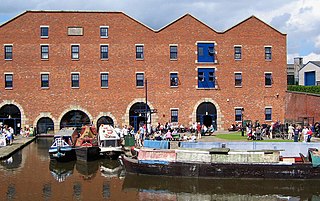
Dukinfield Junction is the name of the canal junction where the Peak Forest Canal, the Ashton Canal and the Huddersfield Narrow Canal meet near Ashton-under-Lyne, Greater Manchester, England. The area has been designated by Tameside Metropolitan Borough Council as a conservation area.

The Horseboating Society is a national society, with the primary aim being the preservation and promotion of Horseboating on the canals of Great Britain. The Society was founded on 19 January 2001 at the Ellesmere Port Boat Museum, and it is the only organisation in the UK solely dedicated to horseboating.

Cavendish Mill is a Grade II* listed former cotton spinning mill in Ashton-under-Lyne, Greater Manchester, in the United Kingdom. It was built between 1884 and 1885 for the Cavendish Spinning Company by Potts, Pickup & Dixon of Oldham. Cavendish Mill was next to the Ashton Canal Warehouse at Portland Basin. It ceased spinning cotton in 1934 and was then used for a variety of purposes before it was converted into housing in 1994.

The Junction Mills were cotton spinning and weaving mills to the west of the Portland Basin in Ashton-under-Lyne, Greater Manchester, in England. They were built between 1831 and 1890 for the Samuel Heginbottom and his sons. The firm went out of business in 1930, and all the buildings have been demolished but the 210 feet (64 m) octagonal chimney, built in 1867, and typical of that period has been preserved in situ.

Fellows Morton & Clayton Ltd was, for much of the early 20th century, the largest and best-known canal transportation company in England. The company was in existence from 1889 to 1947.

Narrow Boat is a book about life on the English canals written by L. T. C. Rolt. Originally published in 1944 by Eyre & Spottiswoode, it has continuously been in print since.
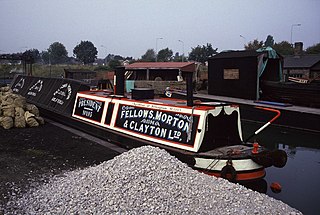
President is a historic, steam-powered narrowboat, built in 1909 by Fellows Morton & Clayton (FMC) at their dock at Saltley, Birmingham, England. It is now owned by the Black Country Living Museum, where it is based. President is registered by National Historic Ships as part of the National Historic Fleet.

A widebeam is a canal boat built in the style of a British narrowboat but with a beam of 2.16 metres or greater.




























